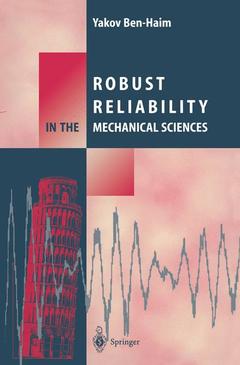1 Preview of Robust Reliability.- 1.1 Flexible Solar Panel.- 1.2 Quality Control of Thin Shells.- 1.3 Fatigue Failure and Reliability.- 1.4 Plastic Extrusion Manufacturing.- 1.5 Summary.- 2 Convexity and Uncertainty.- 2.1 Complex Uncertainty and Limited Information: Four Examples.- 2.2 Some Convex Models.- 2.3 Expansion of Convex Models.- 2.4 The Structure of Convex Sets.- 2.4.1 Definition of Convexity.- 2.4.2 Extreme Points and Convex Hulls.- 2.4.3 Extrema of Linear Functions on Convex Sets.- 2.4.4 Hyperplane Separation of Convex Sets.- 2.4.5 Linear Systems Driven by Convex Input Sets.- 2.5 Clustering of Uncertain Events: The Convexity Theorem.- 2.6 Problems.- 3 Robust Reliability of Static Systems.- 3.1 Introduction.- 3.2 Beam With An Uncertain Distributed Load.- 3.2.1 Uniform Load Uncertainty.- 3.2.2 Shifted Uniform Load Uncertainty.- 3.2.3 Load-Uncertainty Envelope.- 3.2.4 Fourier Ellipsoid-Bound Uncertainty.- 3.3 Cooling Fin in an Uncertain Flow Field: Reliability and Design.- 3.3.1 Uniform Blade.- 3.3.2 Optimal Thickness Profile.- 3.3.3 Optimal Width and Thickness Profiles.- 3.3.4 Minimum Weight Design.- 3.3.5 Parameter Sensitivity of the Reliability.- 3.4 Beam in Compression With Uncertain Initial Imperfections.- 3.4.1 Band-Limited Energy-Bound Convex Model.- 3.4.2 Fourier Representation of Y (?, N0, N1).- 3.4.3 Maximum Additional Bending Moment.- 3.4.4 Critical-Energy Failure Criterion.- 3.5 Radial Buckling of Thin-Walled Shells; Reliability and Quality Control.- 3.5.1 Localized Imperfections.- 3.5.2 Fourier Ellipsoid-Bound.- 3.6 Reliability of Serial and Parallel Networks.- 3.7 Problems.- 4 Robust Reliability of Time-Varying Systems.- 4.1 Mass and Spring System.- 4.2 Seismic Safety of Secondary Equipment.- 4.2.1 Dynamics.- 4.2.2 Reliability with the Fourier-Envelope Model.- 4.3 Multi-Dimensional Vibrating Structures.- 4.3.1 Formulation.- 4.3.2 Reliability: Hyperplane Separation.- 4.3.3 Input Reliability.- 4.4 Modal Reliability.- 4.4.1 Formulation.- 4.4.2 Coordinate Transformations.- 4.5 Axially Loaded Thin-Walled Shell With Imperfect Initial Shape.- 4.5.1 Dynamics.- 4.5.2 Fourier Ellipsoid Bound.- 4.6 Fatigue Failure and Reliability With Uncertain Loading.- 4.6.1 Damage Evolution.- 4.6.2 Uncertain Load Histories and Maximum Damage Increment.- 4.6.3 The Least-Lifetime Recursion.- 4.6.4 Least-Lifetime With Uncertain Harmonic Loads.- 4.6.5 Fatigue Reliability With Uncertain Harmonic Loads.- 4.6.6 Fatigue Reliability With Complex Uncertain Loads.- 4.7 Problems.- 5 Fault Diagnosis, System Identification and Reliability Testing.- 5.1 Benchmark Diagnostic Resolution: Simple Examples.- 5.1.1 Formulation.- 5.1.2 Single Measurement.- 5.1.3 Variable Measurement Position.- 5.1.4 Multiple Measurements.- 5.1.5 Hyperplane Separation.- 5.1.6 Reliability With Two Measurements.- 5.2 Multi-Hypothesis Diagnosis of Anomalous Inputs.- 5.2.1 Multi-Hypothesis Diagnosis.- 5.2.2 Criterion for Successful Diagnosis 1ll.- 5.2.3 Example.- 5.2.4 Robust Reliability.- 5.3 Least-Squares Estimation.- 5.3.1 Formulation of the Least-Squares Problem.- 5.3.2 Variation of the Least-Squares Solution.- 5.3.3 Estimating a Spectral Centroid.- 5.3.4 Reliability of “Regularized ” Solution.- 5.4 Multi-Hypothesis Diagnosis of a Crack.- 5.4.1 The Eigenvalue Equation.- 5.4.2 The Multi-Hypothesis Algorithm.- 5.4.3 Performance Criterion for the Diagnosis.- 5.4.4 A Useful Theorem.- 5.4.5 Reliability of the Diagnosis.- 5.5 Robust Reliability of Model-Order Determination.- 5.5.1 Formulation.- 5.5.2 Examples.- 5.6 Ill-Posed Problems.- 5.6.1 Column-Space Analysis.- 5.6.2 Multiplicity of Solutions.- 5.7 Selective Sensitivity.- 5.7.1 Basic Concept of Selective Sensitivity.- 5.7.2 Example: 2-Dimensional System.- 5.7.3 Example: Structural Integrity of a Building.- 5.8 Problems.- 6 Reliability of Mathematical Models.- 6.1 Models, Decisions and Reliability.- 6.2 Cooling Fin With Uncertain Geometry.- 6.3 Modal Truncation of a High-Dimensional Model.- 6.4 Robust Multi-Hypothesis System Identification.- 6.4.1 System Formulation.- 6.4.2 Uncertainty in the Nominal Model.- 6.4.3 Multi-Hypothesis Identification.- 6.4.4 Robustness of Asymptotic Multi-Hypothesis Algorithms.- 6.4.5 Robustness of Finite Multi-Hypothesis Algorithms.- 6.4.6 Hierarchical Multi-Hypothesis Algorithms.- 6.5 Problems.- 7 Convex and Probabilistic Models of Uncertainty.- 7.1 Uncertainty Is Not Necessarily Probabilistic: The Three-Box Riddle.- 7.2 Models of Uncertainty: A Comparison.- 7.3 Limitations of Probability.- 7.4 Sensitivity of the Failure Probability: An Example.- 7.4.1 Uncertainty in the PDF of the Load.- 7.4.2 Sensitivity of the Failure Probability.- 7.4.3 Design Implications.- 7.5 Problems.- 8 Robust Reliability and the Poisson Process.- 8.1 The Poisson Distribution.- 8.2 Dynamic System with Uncertain Loads.- 8.3 Shells With Geometric Imperfections.- 8.4 Damage and Annealing Processes.- 8.4.1 Birth and Death Process.- 8.4.2 Damage and Annealing: I.- 8.4.3 Damage and Annealing: II.- 8.5 Problems.- 9 Last But Not Final.- 9.1 Recapitulation of Robust Reliability.- 9.2 Subjective Calibration of Robust Reliability.- 9.2.1 Calibration by Consequence Severity.- 9.2.2 Calibration by the Information Gap.- 9.3 Reliability and Social Acceptability.- 9.4 Robustness as a Managerial Strategy.- References.- Author Index.

